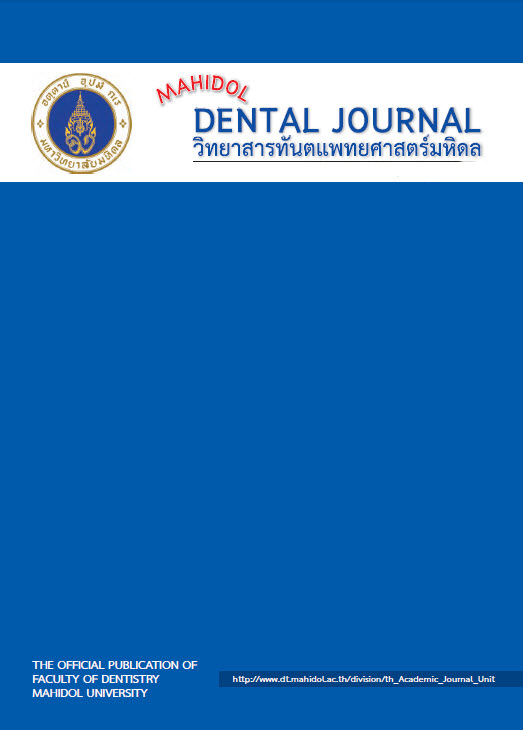H angle hard tissue, H angle soft tissue and visual perception of a facial profile of a skeletal type II Thai female
Main Article Content
Abstract
Objectives: To compare the correlation of H angle hard tissue and H angle soft tissue with the visual perception of skeletal type II patients.
Materials and Methods: 59 lateral cephalograms of female patients from year 2016 to 2018 were hand traced and analysed by using ANB > 5.69 to define skeletal type II category. The principal investigator then traced the soft tissue profile outline of the cephalograms and transformed it into silhouettes for performing profile rating by the specialists. Profile ratings were done by two orthodontists on Visual Analogue Scale (VAS) with increasing levels of convexity. Rankings of visual perceptions (profile rating) were correlated with cephalometric measurements using Spearman correlation coefficient.
Results: Our result showed that there was no statistically significant difference between the correlation of H angle hard tissue with the visual perception and the correlation of H angle soft tissue with the visual perception. The analysis of correlation between H angle hard tissue and H angle soft tissue showed a statistically significant correlation. The increase in facial convexity was correlated with higher values of both H angle hard tissue and H angle soft tissue. In this study, H angle hard tissue and H angle soft tissue showed comparatively an almost equal correlation with values of 0.63 and 0.65 respectively.
Conclusion: Both H angle hard tissue and H angle soft tissue had almost equal agreement with the visual perception. Hence either one of the H angles (H angle hard tissue or H angle soft tissue) can be used in cephalometric analysis to determine the facial profile of a skeletal type II patients.
Article Details
References
Reyneke JP, and Ferretti C. Clinical assessment of face. Semin Orthod 2012;18 :172-186
Mangeet AO. Classification of skeletal and dental malocclusion; Revisited. Stomatology Edu Journal 2016; 3: 38-44
Hussels W and Nanda RS. Analysis of factors affecting angle ANB. Am J Orthod Dentofacial Orthop 1984; 85: 411-423
Holdaway RA. A soft tissue cephalometric analysis and its use in orthodontic treatment planning- part I. Am J Orthod Dentofacial Orthop 1983; 84:1-28
Farkas LG. Anthropometry of the Head and Face in Medicine. Elsevier North Holland Inc, New York 1981; 84:52-60
Gavan JA, Wasburn S L, Lewis P H. Photography: An Anthropometric tool. Am J Physical anthropometry 1952;10: 331-351
Neger M A. A quantitative method for the evaluation of the soft tissue facial profile. Am J Orthod Dentofacial Orthop 1959; 40:284-318
Guess M B and Solzer WV. Computer treatment estimates in Orthodontics and Orthognathic surgery. J Clin Orthod 1989; 23:262-268
Roos N. Soft tissue changes in Class II treatment. Am J Orthod Dentofacial Orthop 1977; 72:165-175
Garner L D. Soft tissue changes concurrent with orthodontic tooth movement. Am J Orthod Dentofacial Orthop 1974; 66: 367-377
Merrifield L L. The profile line as an aid in critically evaluating facial aesthetics. Am J Orthod Dentofacial Orthop 1966; 52: 804-822
Stoner M M. A photometric analysis of the facial profile. Am J Orthod Dentofacial Orthop 1955; 41: 453-469
Arnett G W. Soft tissue cephalometric analysis; diagnosis and treatment planning of dentofacial deformity. Am J Orthod Dentofacial Orthop 1999; 116: 239-253
Yin L, Jiang.M, Chen W, Smales R J, Wang Q, Tang L. Differences in facial profile and dental aesthetics perception between young adult and orthodontist Am J Orthod Dentofacial Orthop 2014; 145(6): 750-756
Daniel WW, Cross CL. Biostatistics; A foundation of analysis in the health sciences: 2013; 10: 189-90p
Arnett G W and Bergen R T. Facial keys to Orthodontic diagnosis and treatment planning-part I. Am J Orthod Dentofacial Orthop 1993; 103: 299-312
Hwang H S, Kim W S, Mc Namara J A. Ethnic difference in soft tissue profile of Korean and European-american adults with normal occlusion and well-balanced faces. Angle Orthod 2012; 72: 72-80
Javadpour G F and Khanemasjedi M. Soft tissue facial profile and anteroposterior lip positioning in Iranians. Journal of Dental school Shahid Beheshti Univeristy of medical sciences 2014; 32: 90-95
Marchiori GE, Sodre LO, Da Cunha TC, Torres FC, Rosario HD, Paranhos LR. Pleasantness of facial profile and its correlation with soft tissue cephalometric parameters; Perception of Orthodontists and lay people. Eur J Dent 2015; 9: 352-355
Morihisa O and Liliana A M. Comparative evaluation among facial attractiveness and subjective analysis of facial pattern. R Dental Press Orthop Facial 2009; 14: 462-469
Reis, S A B, Abrao J, Claro, Claro CADA, Filho L C. Dental Press J Orthod 2011; 16: 57-67
Angle E H. Classification of Malocclusion. Dental cosmos 1899; 41:248-265
Haque S, Nowrin S A, Shahid F, Alam, M K. Global prevalence of malocclusion 2018; 17-30
Soh J, Sandham A, Chan Y H. Malocclusion severity in Asian men in relation to malocclusion type and orthodontic treatment need. Am J Orthod Dentofacial Orthop 2005; 128: 648-52
Sharma P, Arora A, Valiathan A. Age changes of jaws and soft tissue profile. Scientific world journal 2014;10: 1-7
Amer M E, Labib A, Hassan A. Correlations between lateral cephalometric and facial attractiveness of Egyptian adolescents. IOSR J Dent Medical sciences 2015; 4: 80-88
Naqvi Z, Shaikh K, Pasha Z. Perception of facial profile and orthodontic treatment outcome-patients opinion in treatment plan. Int dent med J adv res 2015; 1: 1-5
Collins, Magaret. The Eye of the beholder; Face recognition and perception. Seminars in Orthodontics 2012; 18: 229-234


